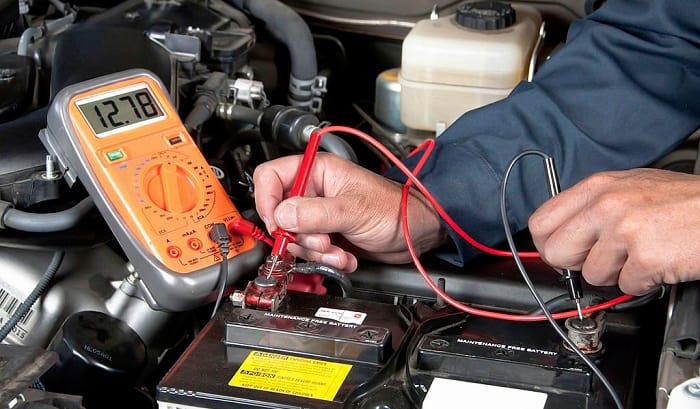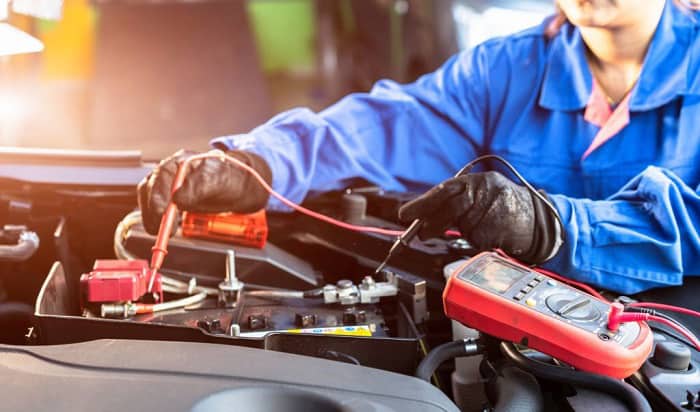A battery significantly contributes to your vehicle, particularly during the startup process. To get its motor running, your vehicle requires a higher current than is necessary for normal operation.
Most mid-size automotive engines require an average of 400 amps. However, larger engines may require more than 1,000 amps.
That said, to determine how many amps to start a car, various aspects must be considered.
Table of Contents
How Many Amps Does a Car Battery Need to Start?
Aside from the engine, one of the most important components of a car is the battery. It provides power to the engine and other electrical components.
In usage, the energy requirements during starting are different from those during normal operating conditions.
So, how many amperes are needed to start a car?
- Generally, 400 to 600 amps may be sufficient to start an SUV or any vehicle with mid-size batteries. On the other hand, roughly 1,500 up to 2,000 amps may be necessary to start a truck with large batteries.
At the same time, most little cars only require 200 amps for jumpstarting. As you might notice, the size of the engine is one of the main factors affecting the required amps.
These amp ratings are defined by two measurements: CA (cranking amps) and CCA (cold cranking amps), which are used for different ambient temperatures. These ratings are printed on the label, along with other essential properties of the battery.
- The cranking amps rating of the battery is the amount of electricity it can generate in 30 seconds at 32 degrees Fahrenheit with a minimum of 1.2V per cell. In layman’s terms, this rating reflects how much electricity it can provide under normal weather circumstances.
- Meanwhile, the cold cranking amps are the battery’s energy requirement at 0°F or lower for the same duration and voltage rating as the CA. Simply put, the CCA rating is the energy for starting an automobile in very cold temperatures.
Aside from the amp ratings, there is also a standard voltage required to start a car. In this situation, a 12V battery should have a minimum rating of 12.6V, which increases to 13.7V and 14.7V in operational conditions.
The engine may fail to start if the CA, CCA, and voltage requirements do not meet the engine specifications.
If you want to determine the actual amps to jump start a car, using a battery tester might be very helpful. This will provide you with an exact representation of all the ratings you may desire to see.
All you have to do is enter the information of your battery (such as its type) and begin the test. Note that some tests may require you to do them while running the car’s engine.
Other Factors to Consider That Could Contribute to Higher Amp Draws
1. Oil Viscosity
Oil viscosity is one factor determining how difficult or easy an engine is to run. In general, starting an engine with lower-grade viscosity oil is much easier than starting an engine with higher-grade viscosity oil.
However, this does not always imply that a lower viscosity level is preferable. Higher temperature locations require higher viscosity, whereas colder climates require lower viscosity.
2. Temperature of The Surroundings
Another factor to consider is the ambient temperature. Cold oils are very thick, especially if the weather is 20 degrees or under. This thickness also makes it harder for the engine to spin. Therefore, if you are in a cold area, your car needs a higher CCA.
3. Type of Engine
Normally, a diesel car will pull more energy than a gasoline type of engine (2 vs 1 cold cranking amps per cubic inch of engine displacement).
4. Voltage Calculation
Voltage calculation can be used to determine the charge level or state of charge (SOC) in a car battery. All you need to do is determine the actual voltage of the battery. Usually, there are different ways to do so.
You can use a multimeter, set it to DC voltage at a scale of 12V, and connect the probes to the battery terminals. After that, you will see the voltage rating on display.
After you get the actual voltage reading, compare it to the SOC table below.
Battery State of Charge
| Voltage Level | State of Charge |
| 12.6 volts | 100% |
| 12.4 volts | 75% |
| 12.2 volts | 50% |
| 12.0 volts | 25% |
| 11.9 volts | 0% |
FAQs
Does it Depend on the Weather?
Yes, a low-temperature atmosphere is a significant factor that affects car startups. Cold weather can cause engine oils to thicken, which means higher amps required to start a car.
If you reside in a cold climate, you may need to utilize a battery with a high CCA (Cold Cranking Amps).
In cold weather, the standard CCA for a battery to start a car engine is 650. But if you want to be safe, 800 CCA is the optimal level.
How Many Amps Do You Need to Start a Dead Battery?
In most cases, a dead battery typically needs peak amps of 400 to 500 to start. The bigger the car, the higher the amperage required.
How Many Amps are in a 12 Volt Car Battery?
Typically, a standard 12V battery has an amp rating of 160 but may produce as much as 600 amps. However, the cranking amp rating is more important to consider when choosing a good quality battery.
How Many Watts are there in a 12V Battery?
To get the battery’s total watts, you need to use this formula: Watts = Amps x Volts. So, if you have a 100 Amp Hour, 12.7V battery, you will get a 1,270 Watts Hour rating.
Conclusion
Knowing how many amps to start a car and all of the aspects that influence a vehicle’s cranking will help you identify which sort of battery you may require when purchasing a new one.
Just keep in mind that the size of the engine is the most important aspect in determining the amp rating of the battery.
For instance, if you wish to start a V8 engine, you may want a battery with a higher CA rating, which can be at least 500 CA or more than 1,000 CCA if you reside in a cold climate.
Related Posts about Average Time to Charge a Car Battery at:

I am Edwin Jones, in charge of designing content for Galvinpower. I aspire to use my experiences in marketing to create reliable and necessary information to help our readers. It has been fun to work with Andrew and apply his incredible knowledge to our content.



